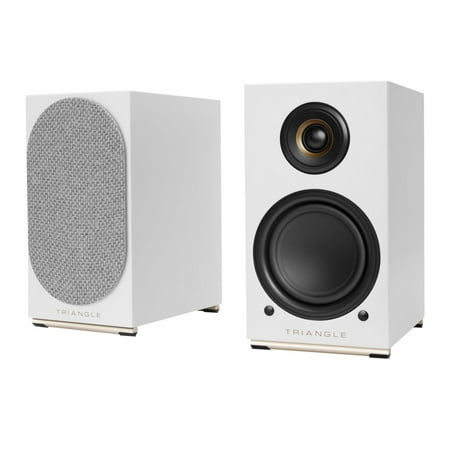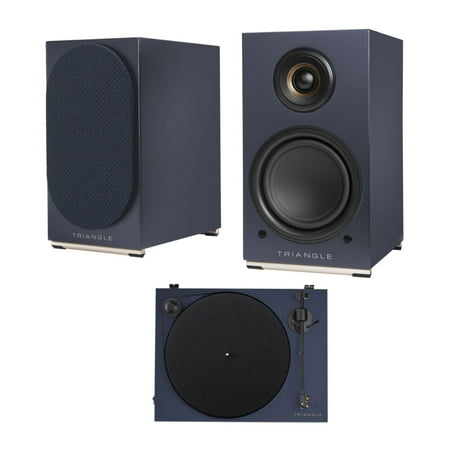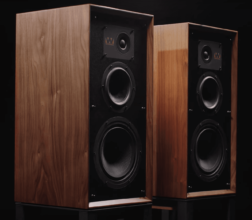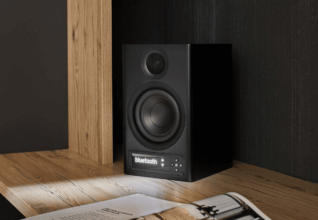TRIANGLE AIO TWIN Review: Three Point Turn
An All-In-One streaming system from Triangle with vinyl replay ability – disguised as a simple pair of loudspeakers. John Pickford dives in.
Active loudspeakers have been the industry standard in recording studios for a good couple of decades. Hi-fi enthusiasts have been slower to catch on, preferring to keep their electronics boxes separate from their traditional passive speakers.

While studio monitors usually feature onboard power amplifiers only, Triangle’s AIO (All In One) Twin system takes the active approach further by incorporating both line-level and moving magnet (MM) phono preamplification.
But that’s just the analog side of things. The AIO Twin is also Bluetooth 5.0 aptX compatible and can stream hi-res audio up to 192kHz/24-bit. This is done via an app you have to download (App Store for iOS or Google Play for Android), then the app will allow you to play music from your chosen service, using your mobile device (‘phone, iPad, etc) as a remote control. I use Qobuz for hi-res streaming, usually via my Leema Stream IV, and this worked faultlessly through the AIO “Twin system.

You also get comprehensive connectivity for other analog and digital sources, with an Auxiliary input (3.5mm mini-jack), Optical input (for TVs), and USB/charge input. There’s also an RJ45 socket should you wish to connect to your router via an ethernet cable rather than use on-board wi-fi.
All of this is located on the rear panel of the active unit, along with a volume/source selection control, subwoofer output, and AC inlet with its accompanying power switch.

Unlike active studio monitors with power amps inside each unit, I should explain that the AIO Twin contains all its electronics within one speaker cabinet. The output terminals then connect to the second passive speaker. Just as if a separate amplifier was providing power, a bespoke 3m cable is provided. Forgetting all the electronic and streaming functions for a second, the loudspeakers are a conventional twoway, bookshelf, bass-reflex design featuring a 130mm woofer and 25mm tweeter.

The woofer features a concave, treated paper membrane with no dust cap. This is said to increase rigidity and efficiency and allows the whole of the surface to be used to produce sound. The silk dome tweeter has been designed for smoothness, with none of the hard, ringing artifacts that often afflict metal dome types, while the shape of the front plate aims to reduce unwanted reflections.

At the base of each speaker is a pair of aluminum feet with rubber pads at each end to provide some isolation between the cabinet and whatever it’s placed upon; however, the pads slot into the feet rather insecurely and can easily work loose to be potentially lost.
The system comes with a remote control, which, along with various other functions, allows for treble and bass adjustment, which I found useful. Switching between sources using the control alters the LED’s color on the active unit’s front panel.

I encountered no problems or glitches setting up the system for streaming playback and, following the manufacturer’s easy-to-follow instructions, was up and running within 10 minutes. You only need to go through this process during the initial setup, and then you can go indefinitely.


With my Qobuz library accessible, I played You’ve Got A Habit Of Leaving (96/24) from David Bowie’s recently released Toy album. This album was originally recorded in 2000 and featured his then-touring band (with the brilliant Earl Slick on guitar), revisiting some of Bowie’s earliest songs from the 60s. The track features a solid rock sound, and the AIO Twin delivers more punch than I expected. There’s not much in the way of deep bass on the track, yet the AIO “Twin didn’t flinch at revealing both the attack and midbass thump of the kick drum and the underpinning bass guitar line.
The broad midrange, where Bowie’s effect-laden vocal competes for space with over-driven guitars, piano, and lush backing vocals, displayed great depth of image to give a sonic presentation that was at once both forceful yet relaxed; there was no tendency to shout. I didn’t miss the deep bass larger loudspeakers give. However, dyed-in-the-wool bass heads might want to consider Triangle’s matching Tales 340 subwoofer, which connects to the active Twin via a mini-jack connector.
“gently shimmering chimes and sweeping strings added to the icy atmosphere”
Another recent historic release by a legendary artist – Neil Young: Carnegie Hall 1970 (192/24) – features a solo performance in this large hall. During Cinnamon Girl, my attention was drawn to both the hall’s ambiance and the plectrum’s leading edge against the guitar string. Treble detailing and atmospherics were more obvious than when I played the track through my Rogers LS3/5a monitors, and here I made use of the treble control to ever-so-slightly tame the reverb and make ol’ Neil sound a little less ghostly.
A more contemporary studio recording – Alexandra by Laura Marling (96/24) – also benefited from a little treble cut, which helped sit the close-mic’d lead vocal more naturally into the mix, creating a more even presentation from top to bottom.
Led Zeppelin’s Kashmir, from their 1975 opus Physical Graffiti (96/24), is a dense production of epic proportions. In this instance, the AIO Twin’s default EQ setting helped to define the massed horns, strings, and mellotrons for a more lively rendition of what can be a lament on dull or overly warm systems. John Bonham’s kick drum had enough impact, and although I wouldn’t have expected to hear the thunderous low-end, I heard through big Tannoys; for example, texture and timing were excellent from the compact system.
I switched to vinyl via my Goldring Lenco GL75 and played John Coltrane’s A Love Supreme (Impulse 1965). I was impressed with the quality of the onboard phono stage, which enabled replay with all the musicians’ intense dynamics and emotions intact. Switching back to Qobuz, the Coltrane track streaming at 96/24 gained extra stamina and revealed the AIO Twin’s excellent, naturally delineated tonal properties.
On a wet and windy afternoon listening to Scott Walker, I had to play It’s Raining Today from Scott 3 (96/24). This system highlighted the generous studio reverb, while the gently shimmering chimes and sweeping strings added to the icy atmosphere; it was a delicious recording detailing.
I was extremely impressed with this feature-packed system from Triangle. The sound quality is superb for the price, and it may well prove to be a more synergistic option than finding a match made in heaven with separate amp and loudspeakers. It won’t win over those who prize their multibox amplification systems, with attendant power supplies and main conditioners, but that’s not the target audience. For those wishing to enjoy all of their music collection, regardless of format, with excellent sound quality from an uncluttered system, the AIO Twin is an exceedingly elegant solution.
MEASURED PERFORMANCE
With the Treble and Bass level controls set to their default (reset) 12 o’clock position on the app. frequency response of Triangle’s AIO (All In One) active loudspeakers, as shown, ran reasonably evenly from 90Hz up to 5kHz, after which output from the tweeter rises by +3dB or so, enough to make the sound balance bright. However, the Treble control dialed back a little to 11 o’clock cured this, so there is room to adjust output to a reasonable tonal accuracy. Maximum lift on both controls was a massive +10dB, and there was an equivalent cut, so plenty of room for adjustment is available. With a small port tuned to 60Hz, giving little acoustic
power and a steep roll-off below 90Hz from the forward driver, deep bass will be minimal. Turning up the bass control raised the upper bass rather than the low bass.
FREQUENCY RESPONSE
Green – driver output
Red-port output

www.scvdistribution.co.uk
Gallery


VERDICT
When you purchase through links on our site, I may earn an affiliate commission. Here’s how it works.
Wireless AIO TWIN speakers Bluetooth, Wi-Fi & Multiroom - Triangle Hi-Fi (EN)
Discover the AIO TWIN speakers, packed with technologies and TRIANGLE know-how. With all the features and performances of ...
















How does the Triangle AIO Twin compare in sound quality with the QAcoustics M20 HD? And which sub would be recommended with either of these two systems?